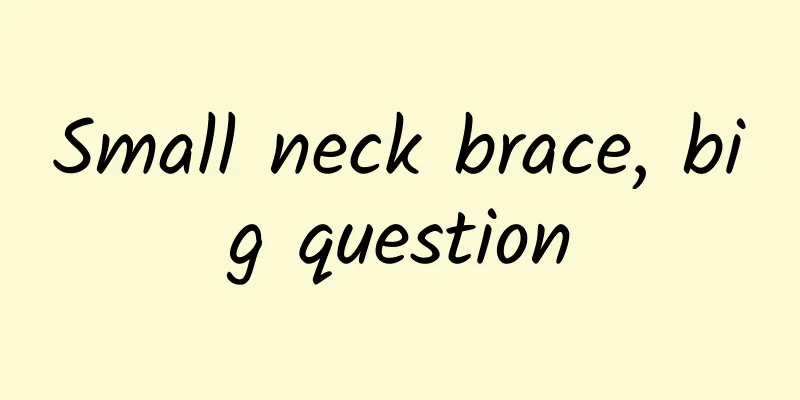Small neck brace, big question

|
Authors: Wei Cuicui, Luo Yan, Wu Airong, Zhang Huanhuan; Chief Judge: Zhai Hua Unit: Shanghai Yangzhi Rehabilitation Hospital (Shanghai Sunshine Rehabilitation Center) This popular science work is one of the popular science materials in the series "Don't be afraid of spinal cord injuries, there are ways to prevent and rehabilitate them" Recently, the "anti-bowing artifact" has become popular on major e-commerce platforms. Is the "anti-bowing artifact" really useful? Many people have doubts. In this regard, experts pointed out that the essence of the "anti-bowing artifact" is a neck brace, which may have a certain effect on changing bad posture. But for healthy people, the neck is in motion all the time, and the muscles need support during the activity. If the neck brace is worn for a long time, it may cause muscle atrophy and accelerate the degeneration of the cervical spine. The "anti-bowing artifact" can indeed correct the habit of bad posture to a certain extent, but healthy people must not rely on it. To relieve shoulder and neck pain and improve posture, you still have to start with habits. Maintaining good posture habits can fundamentally prevent cervical spondylosis. So, in what situations will a cervical brace be used? Experts point out that cervical braces are often used to protect the cervical spine after cervical surgery, to maintain safety during the recovery process of the cervical spine, and are also used for conservative treatment of cervical spondylosis to relieve the symptoms of cervical spondylosis. Since cervical braces play an important role in protecting and treating the cervical spine, do you know how to choose and wear a cervical brace? If you are still a novice, please be sure to read this carefully, as it can be said that " a small cervical brace is a big question ". 1. Who needs to wear a cervical collar? 1. Cervical vertebra fracture and dislocation 2. After cervical traction treatment, before and after cervical surgery 3. Cervical disc herniation 4. Cervical spondylosis 2. What are the commonly used neck collars? 1. Ordinary neck brace: Made of felt or similar materials. Choose the right neck brace model. The felt pad "supports" the cheeks, keeps the head-chin-neck in a slightly flexed position, prevents the head from tilting back, and avoids hyperextension of the neck. 2. Liftable cervical brace (also known as hard cervical brace): It is made of hard plastic, and some are equipped with metal supports or adjusters. It has a greater fixing and restricting effect and is mostly used for acute and severe injuries of the neck, such as cervical fractures and dislocations. 3. Inflatable neck brace: Made of rubber, it is like a spring. It is worn on the neck first and then inflated. The amount of inflation can be determined according to each person's neck size, purpose and condition. This neck brace is more practical and can meet the needs of different groups of people. 3. What are the functions of a neck brace? To put it simply, when the cervical spine is injured or suspected to be injured, the patient is given a neck brace to immobilize the neck, which can prevent the cervical spine from being injured again during activity or transfer. 4. How to choose a suitable cervical collar? Different patients need to wear different types of cervical collars. When choosing a cervical collar model, the following data should be measured: Method for measuring neck height: the thumb and index finger are at 90 degrees, the upper edge of the neck height is when the index finger is flush with the horizontal line of the mandibular angle, and the lower edge is when the shoulder and neck junction is flush with the acromion. Neck height: The vertical distance from the mandibular angle to the supraclavicular fossa. This measurement should match the height of the collar. If the patient's measurement is between two consecutive sizes, try the smaller size first. Neck circumference: The maximum circumference of your neck. This measurement should match your neck circumference. 5. How to wear a neck brace correctly? Taking the hard neck brace as an example, the steps for wearing it are as follows: Step 1 : After selecting the appropriately sized cervical collar, place the back piece of the collar behind the patient's neck so that the collar is centered. Step 2 : Place the patient's lower jaw stably in the groove of the front piece of the cervical collar. The front piece of the cervical collar presses the back piece to ensure effective fixation. Step 3 : Use Velcro to adjust from both sides and tighten the neck collar without affecting the patient's normal breathing. How to wear a cervical collar - lying position Step 1 : The patient lies on his back, with both hands placed on his chest and his lower limbs flexed, to assist in turning over along the axis, so that the head, neck, shoulders, and trunk remain in the same straight line; Step 2 : Support your head and neck with one hand, and use the other hand to fit the back of the neck brace against the back of your neck to help you lie flat; Step 3 : Adjust the position of the neck support so that the upper edge of the back half of the neck support is placed below the earlobe, tilt the head back slightly, place the front half of the neck support on the front of the neck, place the chin on the protruding part of the neck support, and overlap the front and back pieces; Step 4 : Tighten the strap, adjust the tightness to the appropriate level, and open your mouth so that it does not affect your breathing and swallowing. Step 5 : Be careful to avoid moving the injured person's head, neck, and spine. 6.What are the precautions? (Some pictures in this article are from the Internet) References: [1] Li Shuzhen. Cervical spine instability, not suitable for long-term wearing of cervical brace[J]. Healthy Life, 2019(12):33-34. [2] Xiao Qi. Effect of cervical brace in pre-hospital emergency treatment of patients with cervical spine injury[J]. Chinese Contemporary Medicine, 2019, 26(33): 101-103+107. [3] Wang Zhongyu. “Anti-bowing artifact”: wearing it for a long time is not good for the cervical spine [J]. Family Medicine. Happy Health, 2022(04):83. [4] Lei Lihua, Li Xiaofang, Deng Kun, Tian Ling, Zhang Liping, Lei Xia. Analysis of the effects of hydrocolloid dressing and foam dressing in reducing the incidence of medical device-related pressure injuries in patients with cervical spinal cord injury with cervical collar fixation[J]. Chinese Journal of Folk Therapy, 2022, 30(14): 92-94. [5] Liu Bijun, Tang Tingting, Zhang Taihu, Xue Ruchuang, Qiao Bin. Analysis of the application of cervical collar in pre-hospital emergency treatment of patients with severe trauma[J]. Systems Medicine, 2022, 7(12): 84-87. |
<<: RivalIQ: LinkedIn Benchmark Report 2023
Recommend
How to prevent yellow leucorrhea with bad smell
Some women have yellow leucorrhea with a foul odo...
Is menopause a disease?
Menopause is a hurdle that every middle-aged woma...
How to quickly eliminate red acne marks
The red acne marks on the face must be a worry fo...
Is it suitable to eat bananas during menstruation?
Bananas are a very delicious food and are rich in...
Can I drink mutton soup after miscarriage?
After an abortion, in order to restore the body t...
How to calculate the menstrual cycle more accurately?
Women's menstruation is very important to wom...
Causes of recurrent bacterial vaginosis
Most married women often suffer from vaginitis. T...
IDC: China's wireless Bluetooth headset market shipments in the first half of 2023 will be 45.88 million units, down 0.1% year-on-year
According to IDC's "China Wireless Heads...
After women urinate, a few drops of urine will come out
In daily life, many reasons can cause physical di...
What are the symptoms of numbness in women's hands and feet?
The elderly often experience limb numbness, somet...
What to do if you have pubic pain after giving birth
Giving birth is a very painful process. Carrying ...
What should I pay attention to during my menstrual period?
Girls have a few very troublesome days every mont...
Ovulation occurs on the first day after menstruation
If you have sex on the first day after your perio...
Is it normal to have breast tenderness before your period?
Mature women have menstruation every month, but b...
A hard lump on the labia
With the changes in living environment, more and ...









